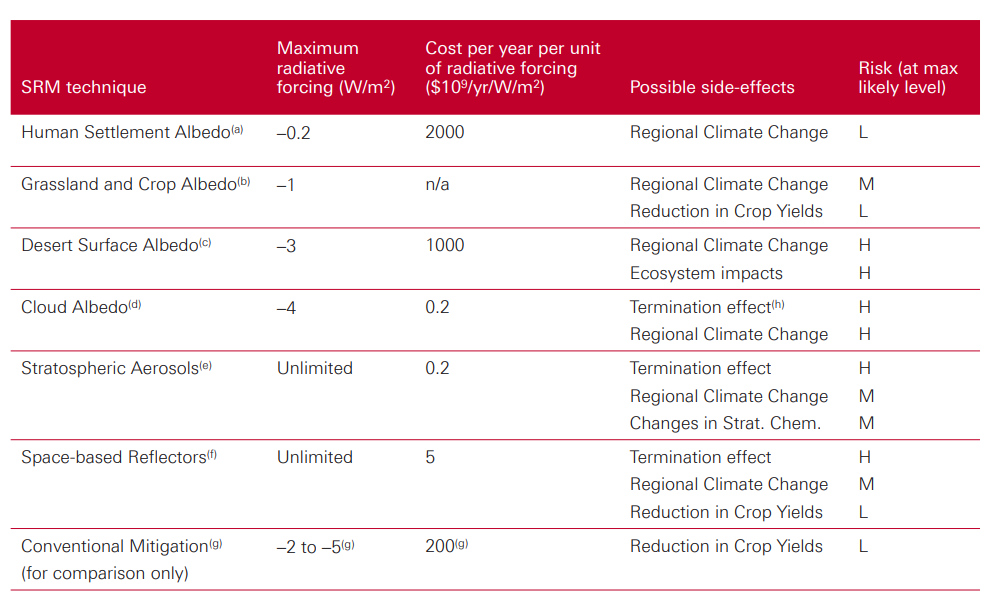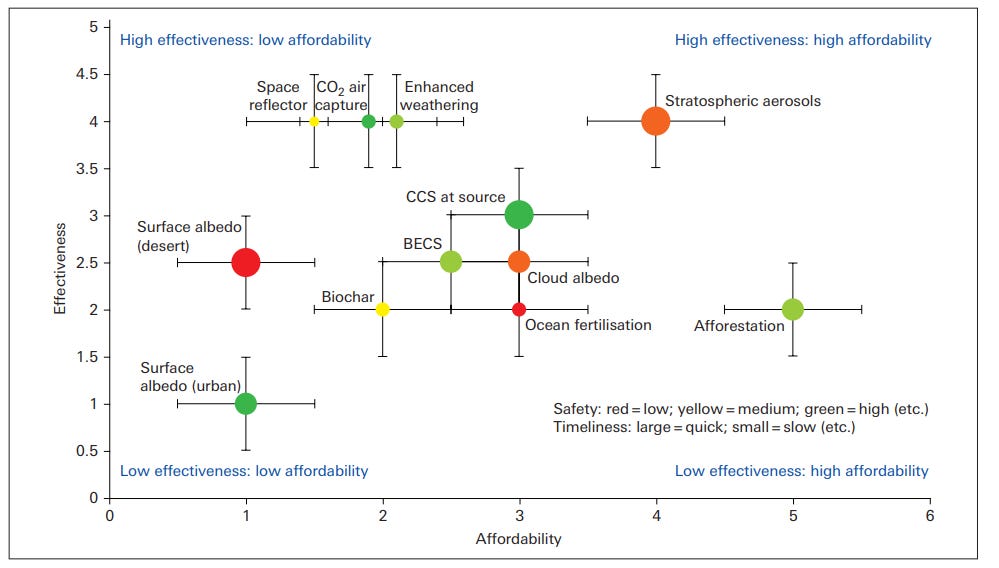Solar Radiation Management - a way out?
The difference between the rhetoric on climate change and the set of solutions that activists deem “acceptable” is baffling.
While activists claim to be concerned about the hypothetical world’s poor of the future they apparently have no moral problem with or are completely oblivious about how their preferred policies are negatively impacting real people of the present.
Practically any technique that does not require a complete destruction of today’s economy and a recreation of it as a global, top-down technocracy directing all business to act in the interest of all (as defined by the technocrats), seems out of bound and at least one of the reasons behind opposition to nuclear power, large-hydro or CCS. But there is an even more taboo topic: geoengineering. More specifically: Solar Radiation Management (SRM).
How we try to regulate the earth’s temperature
Our current approach is somewhat indirect. We know that global temperature is determined by how much solar radiation is kept in the atmosphere; we know that so-called greenhouse gases change how and how much heat is kept on the planet. Without this effect, the average global temperature would be about 30°C lower than it is now. We know that CO2 is a greenhouse gas. Because the amount of CO2 grows, we expect global temperatures to increase and various adverse effects from that. We know that fossil fuel usage increase the concentration of CO2 in the atmosphere. So if you do not want rising temperatures from CO2, you have to stop increasing the concentration of CO2. And that means you have to cut fossil fuel consumption to zero. The rub is of course that 80% of our global energy usage comes from fossil fuels, powering everything we define as modern life-style, from central heating and AC, to refrigerators hospitals, ambulances, our agriculture, mobility, electricity, building, mining, water and waste treatment, clothing and so much more. People do not generally like to even think about giving up any of these. But without affordable zero-carbon alternatives, exactly that is the ask of activists today.
How we could regulate the earth’s temperature
SRM does not care about the level of CO2 in the atmosphere. It is concerned with the global temperature, and tries to control it by changing how much solar radiation is absorbed in a reversible way.
Among the methods that are being contemplated seriously1 are: installing a huge fleet of mirrors in space to reflect some sunlight away, building a fleet of robotic sea vessels that spray enormous amount of water into the air to seed clouds, which reflect sunlight and using a fleet of flying vehicles2 to inject reflective particles into the stratosphere.
And astonishingly, some of these techniques are so cheap that scientists worry that a rogue billionaire could change global temperatures. Research for Copenhagen Consensus shows that just $9 billion spent building nineteen hundred seawater-spraying boats could prevent all predicted temperature increases projected to be caused by CO2 in this century.
If you compare that price with a predicted $60 trillion in damages in the twenty-first century that would come from unmitigated global warming, it seems like a bargain.

And precisely because it looks like changing the planet’s temperature might be cheap and easy, it is not understandable why climate scientists are not working overtime to understand and experiment as much as possible to know as much as possible about its potential negative impacts. A cursory glance at the published literature reveals at least an equal amount of papers dealing with moral questions and potential governance structures for deploying hypothetical forms of SMR as papers actually dealing with it.3
This apparent lack of rigor in qualifying the techniques is especially inexplicable, if scientists and activists were really as worried about potential tipping points as they claim. If they existed, the world might be in need for a rapid decrease in temperature. That is exactly what SRM could deliver. The Mount Pinatubo eruption was a kind of natural experiment for SMR, because it spewed vast amount of sulfur aerosols into the atmosphere, which reflects sunlight. This eruption decreased global average temperatures by a bout 1°C in a matter of weeks.
Not surprisingly, a cost-benefit-analysis undertaken for Copenhagen Consensus found that every dollar spent on research in this area could lead to a total benefit worth $2000.

Given the high confidence that climate scientists apparently have in their mastery of modeling the world’s climate from physical principles over timespans of a hundred years or so to a degree of detail sufficient for demanding a sweeping redo of the world’s political and economic systems, it should be a trivial task to predict the effect of local geoengineering efforts. And in deed the demand to work on this more thoroughly has been around since at least 2015.
Why do we not do it the smart way?
The language used in describing SMR might be revealing of the baffling gap in the potential of this technique and funding to research it. For example the language used to describe a real downside of SRM (once you start doing it, you better make sure that you don’t stop doing it) in this paper seems quite revealing of a general stance towards fossil fuels, the industry producing them and fixing their downsides by technology instead of by changing human behavior:
The addictive character of this techno-fix will not encourage decreasing our CO2 emissions and if stopping this geoengineering scheme was mandatory for whatever reason (unexpected effects, financial crisis…), the stratospheric sulfate sunshade would rapidly lift and several decades’ worth of warming would hit the Earth and all living organisms with no left time for adaptation.
Although SRM poses new risks, it is sometimes proposed as the ‘lesser evil’. I consider how research and implementation of SRM could be regulated, drawing on what I call a ‘precautionary checklist’, which includes consideration of the longer term political implications of technical change. Particular attention is given to the moral hazard of ‘regulatory drift’, in which strong initial regulation softens through complacency, deliberate deregulation (‘regulatory gift’) and the limited constituency of people with the skills to regulate (‘thin markets’). I propose the strengthening of civil society groups to keep regulators in check.
Of course, SRM is not a panacea. For example, it could influence the overall rain patterns and induce a non-uniform cooling effect, creating “winners and losers”. It is also not concerned with the question of the effects of a change in the ocean’s pH value.
But in evaluating a technology or strategy, the relevant question is not “Is it perfect?”, but “Compared to what?”. Compared with our current experiment of emitting 51 GtCO2eq/y and letting activists try to demonize and suddenly erase 80% of our energy supply, that we know is currently irreplaceable in long-range transport, agriculture, mining, smelting and electricity and so on, SRM seems attractive in terms of costs, scale, and reversibility. Instead of putting a few hundred trillions of dollars on the table in the short term for migrating away from fossil fuels with our current technology5, SRM could buy us time for spare change (relatively speaking) to innovate the costs of alternatives to a point, where the economics work in favor of deploying them at scale.6
It seems to me that the problem for SRM (and probably nuclear fission technology) is that it transforms much of the hatred against “capitalism” from “scientific truth and necessity”, to mere asinine rhetoric. It seems so cheap an easy that proponents of the alleged truth seem to prefer stifling research on it to prevent some rich person or country from doing it voluntarily to the alternative: giving up cherished dreams of world revolution and top-down control (with them at the helm of world affairs, one must assume).
Could it be that the projections of the efficacy of SRM are far too optimistic? Sure! It could be more costly and have far more adverse affects than anticipated. But if that is the case, we need to know. We have to investigate it. I think David Keith [@DKeithClimate], assessment in his 2022 paper gets it right:
[W]e find that the costs of over-confidence in [SRM] can be extreme – climate damages are very large if we rely on [SRM] when it does not work. But we also find that under-confidence in [SRM], or ruling it out when it works, can have comparably high costs. These arise in the form of forgone opportunities to limit costly climate impacts[…] Biased judgments are costly, whatever the direction of the bias. A coin has two sides.
There are verious “science fiction”-esque proposals in the literature ↩︎
Maybe a fleet of cargo airships might help. ↩︎
But that could very well be a fault in my queries. ↩︎
I hope that this is not a nut-picking. But correct me, if I am wrong. ↩︎
Which might be an unreasonable proposal, depending on your assumptions. If you want a prosperous zero-carbon society with only renewable power at the same level of reliability and global average consumption on par with today’s Europeans, you are facing enormous practical problem in mining enough material to transition to a mostly electric society (copper, cobalt, lithium) and replacing a lot of the established processes for producing steel, cement, plastics etc. If you weaken the constraints, for example if you allow for regular mass blackouts, wide-spread poverty, high climate vulnerability and mass starvation, transitioning becomes less challenging, but also less desirable. ↩︎
If for example fusion power, space-based solar power, electrical storage or deep geothermal power would become cheap enough in 50 years to easily power the world and direct air capture devices, SRM would have been one of the most cost-effective innovations in history. ↩︎

